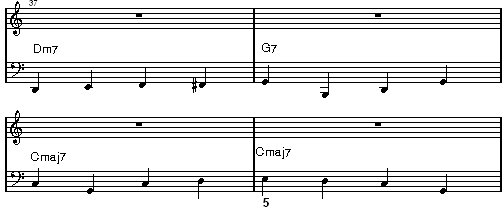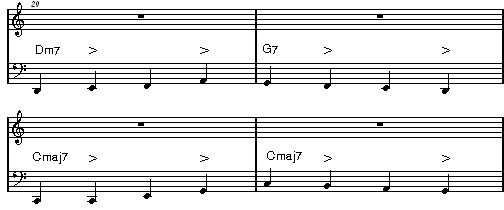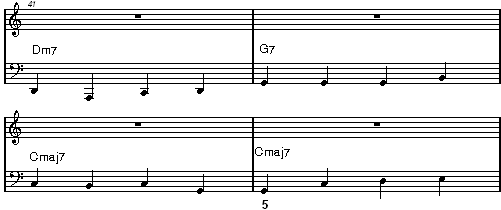Walking bass lines with the piano left hand
The walking bass technique with the piano left hand has great effect. This technique resumes in a direct way the style of a Bass instrument. Obviously the sound of the contrabass is warmer and softer than the percussive sound of the piano and some shadings are impossible with the piano, for example glissando or bender.
Accenting the upbeats is fundamental in this technique. It means to stress notes on the weak beats like the second and fourth one (Time : 4/4)
The rules for the walking bass in a swing jazz style are following:
- Play the fundamental tone of the chord on the first beat, or third or fifth if the chord is repeated. (General Rule with some exceptions)
- Play generally the fundamental, fifth or third one, or passing tones between these chord notes, moving the bass line by half or whole step
- In the chord changing the bass note can go down by fifth, or go up by fourth or move by half or whole step. (General Rule)
- You can play some exceptions if they sound good but be careful.
Let us analyze some examples.

Looking for Piano Direction?
With your FREE Jazzedge Academy account you can access all of our Piano Blueprints and our exclusive 30-Day Piano Playbook. This includes sheet music and backing tracks.
No credit card or payment required. Just great free jazz and blues lessons.
Walking bass | jazz swing style

In this example there is a simple bass line (left hand) playing the fundamental, third and fifth of CMaj7 or C7. Find other variations.
Upbeat accents | walking bass line

Here is explained how to accent the upbeats in a walking bass line (Time : 4/4). I suggest to beat your foot stressing the upbeats. You must learn to clap your hands or the foot on the weak beats of music you hear: this is important in order to acquire the sense of swing and rhythm.
Other examples of swing with bass

In these examples, you can note the use of the passing note (D and F) between the two chord notes (being always C Maj7 or C7).
Example of turning note in walking bass

In these examples, there are the fundamental and the fifth, having the sixth as turning note, that is a note which comes back on the fifth
Chromatic and passing notes in a bass line

Here you can learn how to use passing notes in half steps. In the first example, sixth minor descending between C and E is very nice to hear
Example of walking bass | chord changing

As you can see in all these examples you, walking from a chord to another one, you can use an half step, a tone, you drop fifth, and you rises fourth.
In addition you may note the fifth of the chord in the last one in C Maj7 in order to vary (I could also have used the third).
Remember always to accent the upbeats as indicated in this bass line.
Try to vary the bass line and the interval (jump between two chords). That is, do not change a chord, always using an half step, or a whole step, or a fifth descending or a fourth ascending interval; you have to vary.



